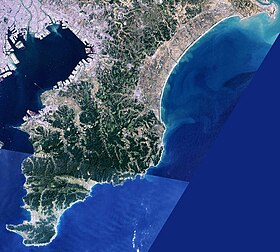Bōsō Hill Range
| Bōsō Hill Range | |
|---|---|
| Bōsō-kyūryō | |

Landsat image of Bōsō Hill Range from Space Shuttle
|
|
| Highest point | |
| Elevation | 408.2 m (1,339 ft) |
| Naming | |
| Pronunciation | [Bōsōkyūryō] |
| Geography | |
| Location | Chiba Prefecture, Honshu, Japan |
The Bōsō Hill Range (房総丘陵 Bōsō-kyūryō?) is a mountain range on the Bōsō Peninsula of Chiba Prefecture, Japan. The highest point in the Bōsō Mountain Range is at Mount Atago, with an altitude of 408.2 m (1,339 ft). The hill range runs from roughly in a line from Mobara or Ōamishirasato to Kisarazu, but is not formally defined. It is an important part of the Minami Bōsō Quasi-National Park.
The Bōsō Hill Range is still extensively wooded. The area from the Yōrō Ravine to Mount Seichō is noted for its forests of live oak. The hill range also has noted forests of oaks, chestnut, Japanese cedar (Cryptomeria), and various species of evergreen. The hill area around Tateyama is noted for its forests of castanopsis trees, a genus of evergreens belonging to the beech family.
The Bōsō Hill Range was settled from the earliest periods of Japanese history. The Yōrō Ravine in present-day Ōtaki, Chiba is home to Jōmon period remains. Kofun tumuli were built across the entire hill range in the Kofun period, but Futtsu and Ichihara have especially rich examples of tumuli. Under the Taika Reform of 645, during the Asuka period, the hill range became part of three provinces, Shimōsa Province to the north, Kazusa Province in the middle part of the range, and Awa Province to the south. The hill range is noted for its richness of castles built during the Sengoku period as part of medieval conflicts.
...
Wikipedia
